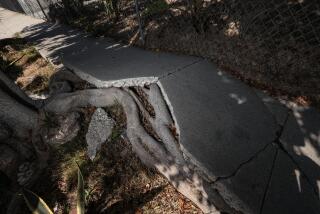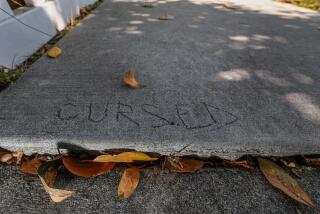One-way’s the way
COUNTY SUPERVISOR Zev Yaroslavsky’s big idea on Westside traffic is proving to be a big pain to some Westsiders. They have reason to be irked about his proposal to convert Olympic and Pico boulevards into one-way streets going opposite directions, because it would probably increase traffic on nearby residential streets and maybe hurt businesses on the wrong side of the road. We sympathize -- but not enough to reject this worthwhile plan.
A study released Monday concluded that the two boulevards, if made one-way between downtown and Santa Monica, could increase traffic capacity by more than 20%. That alone is worth getting excited about because it means considerable relief for the congested Westside, home to more than one-third of the county’s 75 highest-volume intersections. But the really dramatic benefit would be for public-transit riders, who would get two lanes on each street dedicated to buses and vanpools during peak hours.
These new routes could be speedy enough to tempt some commuters out of their cars, easing traffic and reducing air pollution. And the gains would come at a remarkably low price; there aren’t any cost estimates yet for the conversion, but planners believe that it could be done for a few million dollars. Compare that to the roughly $3 billion it would cost to extend the subway along Wilshire Boulevard to Westwood.
Of course, nothing is that simple when it comes to transportation planning. The 20% gain in efficiency only comes if you forbid left turns at intersections; if they’re allowed, you only get a 5.7% gain, the study said. No left turns means serious inconvenience for drivers and added pressure on neighborhoods, because motorists who want to go left probably would cut through residential streets using a system of right turns.
But either way, the transit gains are substantial, and there are other benefits that skeptical neighbors may not have considered. For instance, if there is less congestion on Olympic and Pico, there will be less incentive to use alternatives, potentially reducing residential traffic.
Though the conversion idea was Yaroslavsky’s, he doesn’t have much say over whether it eventually happens -- that’s up to the cities of Los Angeles, Beverly Hills and Santa Monica, where the routes lie. L.A. City Councilman Jack Weiss, at least, appears interested; Tuesday he introduced a motion to study the plan further, though that must be approved by the council’s Transportation Committee. Study can’t hurt, and the potential effect on businesses and residents deserves further analysis. But with traffic worsening all the time, we hope the committee will move quickly. It’s hard not to love what we’ve seen so far.
More to Read
Sign up for Essential California
The most important California stories and recommendations in your inbox every morning.
You may occasionally receive promotional content from the Los Angeles Times.










